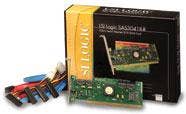Review: LSI SAS Card Geared For High Performance
What's more, the SAS3041X-R connects to a PCI or PCI-X host bus adapter, enabling older configurations to take advantage of SAS drives.

The CRN Test Center reviewed the LSI card with two Seagate drives: the 300 GB Cheetah 15K.5 and 750 GB Barracuda ES. Engineers created a quick I/O benchmark to examine raw performance on each drive by running them individually and then simultaneously, using a PCI-X compatible Intel motherboard.
Each result was compared at various intervals during the process to determine average time differences. The Cheetah drive blew away the older serial ATA (SATA) drive by about 32 percent. A second test using an older Intel PCI motherboard produced similar results.
When combined with the Cheetah drive, the LSI Logic SAS card provides unparalleled I/O performance, making these products ideal for high-performance servers and workstations.
By contrast, the Barracuda ES provides one of the largest storage capacities on a single drive, making it ideal for building network attached storage appliances.
Since the LSI SAS card accepts both drive types, system builders can use it to create systems with many configurations.
The SAS3041X-R comes with four internal SATA 7 pin connectors, with each port capable of delivering up to 3 Gbps. The SAS card's fast access speed allows Cheetah drives to perform with little or no latency during internal I/O or when transferring data.
According to Seagate, the Cheetah drive was designed with enterprise reliability in mind as well. The drive is capable of delivering better sequential access performance than SATA drives and provides an error rate with 10 times more accuracy than previous generations.
Because the LSI card provides connections to SAS and SATA drives, SAS drives have to be connected via a SAS-to-SATA link cable. The SAS-SATA cable also is capable of connecting SATA drives but provides no power. The SATA drives need a 15-POS power cable directly drawn from a system's main power supply.
A different cable also is required when using a backplane that uses a SAS wide port connector. Because an extra power connection is required, a cable with SAS wide port to four SAS connectors is required.
The complexity of having mixed connections is well beyond the Test Center's ability to figure out performance differences between the various port types, so engineers did not test any built-in SAS ports against the LSI Logic card. In addition to Windows, LSI Logic provides connectivity on Linux, which is good news for system builders. With Linux, system builders have to add LSI Logic's Fusion MPT (message passing technology) device management for firmware and drivers to a Linux kernel distribution.
The best way of getting Linux drivers to work with the SAS3041X-R is to add precompiled binaries into an installation or as an RPM update. For this purpose, LSI Logic provides installation instructions in its device drivers and utilities files online.
The company provides drivers for the 2.4 and 2.6 Suse and Red Hat Linux kernels. Like Windows, driver installation code can be transferred to diskettes and installed during boot up. Once the card is recognized, there are several simple and manual steps required to mount the new drives. LSI Logic also provides drivers for various Windows 64-bit editions, Netware and Solaris. In addition to x86, this card can run on SPARC, AMD64 and EM64T system architectures.
The card also is capable of managing several drive types and configurations with LSI's MyStorage management software. My-Storage helps administrators with the task of managing storage arrays by providing a single point of reference that can control all adapters from one centralized server.